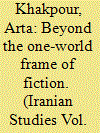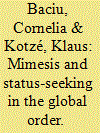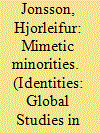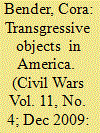|
|
|
Sort Order |
|
|
|
Items / Page
|
|
|
|
|
|
|
| Srl | Item |
| 1 |
ID:
144723


|
|
|
|
|
| Summary/Abstract |
The debate over political commitment in Iran was never limited to adjudicating content: it was frequently a debate over form as well. In the realm of fiction, this debate fixated on realism, the nature of mimesis, and the autonomy of art and the literary text. Within a few short years after forming the iconoclastic journal Jong-e Esfahan in 1965 with a group of likeminded colleagues, the writer Hushang Golshiri had become the preeminent modernist fiction writer in Iran. His critical essays represented a passionate defense of aesthetic autonomy at a time when realism and, particularly, socialist and “engaged” literature were powerful shibboleths in the Tehran literary scene. This paper begins with a look at Golshiri's critical interventions in this debate and then moves on to show how the short stories he produced in the Jong era were an even more integral part of his response to the mimesis question. By reading his stories with a methodology drawn from “possible worlds” theories of narratology, Todorov's fantastic, and Golshiri's own theories, we see how these works break down the “one-world” frame of reality that realism takes for granted, and require the reader to grapple with multiple, often contradictory, possible realities in its stead.
|
|
|
|
|
|
|
|
|
|
|
|
|
|
|
|
| 2 |
ID:
187308


|
|
|
|
|
| Summary/Abstract |
An increasing strand of literature has been studying the dynamics of contestation of the liberal order. Holding that order emergence commences with rhetoric and narratives, this article takes stock of the BRICS summit diplomacy and contestation practices. It pursues a two-level argument. Applying BRICS as a historical case study, the article first reveals how BRICS engages in mimetic performances, re-producing parts of the global order, while simultaneously seeking a re-configuration of the current international system. Second, our analysis shows that through thin and aspiring thick recognition, BRICS countries move toward an enhanced role and status, striving for a better position in the global order. Empirically, to unpack our argument, we analyze BRICS summit diplomacy and rhetoric by unfolding the outcome declarations in the period 2009–2020, as well as BRICS performative practices.
|
|
|
|
|
|
|
|
|
|
|
|
|
|
|
|
| 3 |
ID:
096475


|
|
|
|
|
| Publication |
2010.
|
| Summary/Abstract |
Representations of identity are always political acts, but their politics are unpredictable. Among ethnic minorities in northern Thailand, there is a striking difference between the absence of ethnic markers from a political confrontation and the profusion of ethnic markers at non-confrontational festivals. I situate the difference in engagements with a national contact zone where so-called Mountain Peoples are denied political agency. Minority assertions of ethnic distinction and national compatibility take various forms that resonate with mimesis. Thai notions of Mountain Peoples suggest equally mimetic aspects of self-making through denied similarities. Theoretical approaches to mimesis emphasize interaction and denied resemblance as much as representation. Performances and imagery involving minority identity and difference in northern Thailand contradict common expectations of a fundamental tension between rural and minority communities and the state, and highlight often-overlooked dimensions of identity-work.
|
|
|
|
|
|
|
|
|
|
|
|
|
|
|
|
| 4 |
ID:
103129


|
|
|
|
|
| Publication |
2009.
|
| Summary/Abstract |
Based on my own earlier theorising of 'mimesis at war', and taking up Simon Harrison's suggestion that trophies made from human body parts are best explained as 'transgressive objects', the article focuses on a particular trophy, a nineteenth century Cheyenne finger necklace. Its history illustrates that trophy-taking was part of a broader circulation of practices of war among native warriors and the American military in the West. Finally, trophy-taking made its way into the academic and scientific institutions that provide the discursive frame for present debates about war in anthropology and archaeology.
|
|
|
|
|
|
|
|
|
|
|
|
|
|
|
|
|
|
|
|
|